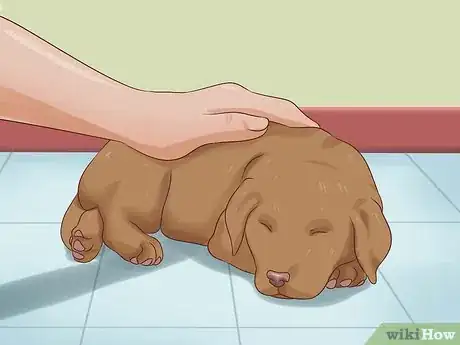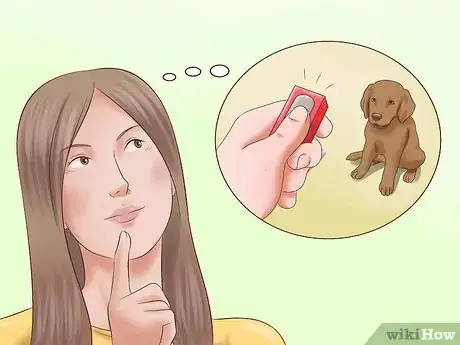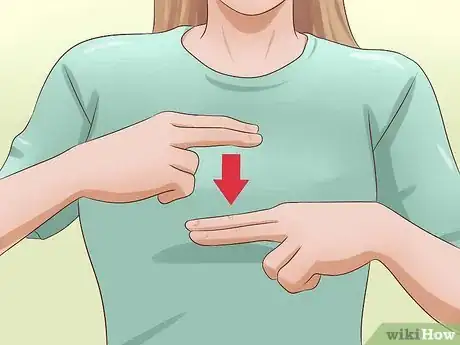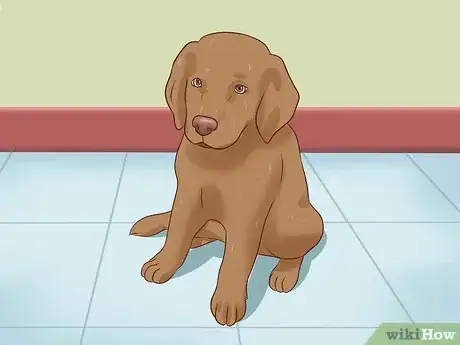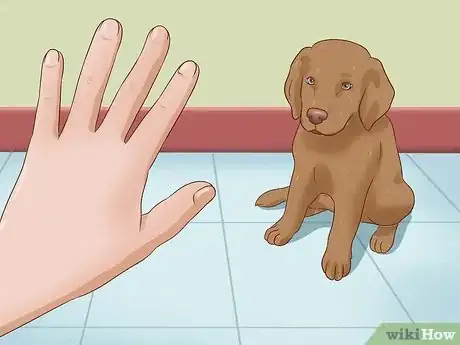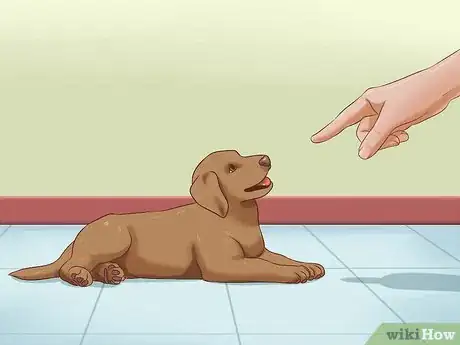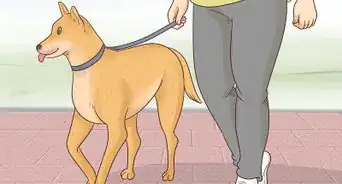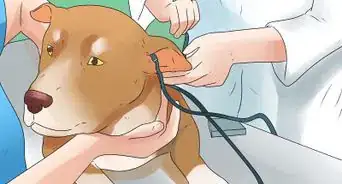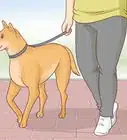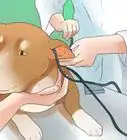This article was co-authored by Toni Woods. Toni Woods is a Professional Dog Trainer in Washington DC. With over 15 years of experience, Toni specializes in improving the relationship between dogs and their families and easing the suffering of dogs experiencing separation anxiety. Toni holds a BS in Biology from Wittenberg University and taught biology for nine years. She now dedicates her life to helping dogs with separation anxiety.
There are 14 references cited in this article, which can be found at the bottom of the page.
wikiHow marks an article as reader-approved once it receives enough positive feedback. In this case, 100% of readers who voted found the article helpful, earning it our reader-approved status.
This article has been viewed 74,585 times.
Deaf dogs were once thought to be difficult to train and aggressive, but neither of these are true, especially for puppies who are born deaf or become deaf at a young age. Training commands is extremely similar to training a normal dog, but does take extra patience and effort, partly because you will be teaching yourself the signed commands as well. Before you get started, it's a good idea to review interaction advice and safety tips that are unique to deaf animals.
Steps
Interacting with a Deaf Puppy
-
1Learn how to get the dog's attention. Thumping on the floor as you approach the puppy will usually work, since even deaf animals can feel vibrations. Flicking the light switch on and off is another option. A flashlight is useful if you let your dog into an enclosed yard at night and need to call it back.[1] [2]
- Vibrating collars are available that will let you get the dog's attention with a remote control. These tools are only useful once the dog has learned some basic training and responds to your command, especially because it takes the dog additional training to get used to the collar in the first place.[3]
-
2Find healthy dog treats. Because your deaf puppy won't get any encouragement from the tone of your voice, food will be even more important during training than it is for other dogs.[4] Find a source of healthy treats that you can provide constantly throughout the day, without giving the dog more than 10% of its calories for the day. Asking the vet is the best way to find a store-bought treat formulated for your dog's needs, but here are a few alternate solutions:[5]
- Try baby carrots, green beans, or other vegetables. Cruciferous vegetables like broccoli, cauliflower, and bok choy can cause gas, and can cause health issues if eaten raw.[6] Never use onions, garlic, chives, or leeks.[7]
- Small pieces of fruit will also work, but remove inedible seeds. Avoid grapes and raisins.[8]
- During early training, you can measure out the amount of food your dog would get from meals throughout the day, and use it constantly throughout the day as treats instead of feeding the dog full meals. You may want to stop this method if it causes the dog to whine or beg more than usual.
Advertisement -
3Make the dog comfortable with being touched. You'll be using touch frequently to get the dog's attention, so it's important to start this training early. While the dog is awake but not paying attention to you, lightly touch it on a convenient area, such as the shoulder or side. Give it a small treat immediately. Repeat this as often as you can for at least a few weeks.[9] Once it learns that being touched in that location is a positive event, you'll be able to get the dog's attention without startling it.
- Train the dog to wake up to a gentle touch as well. Start with your hand under its nose but not touching it, and two fingers of your other hand gently stroking its shoulder and back. Give the puppy a treat as soon as it wakes up.[10]
-
4Keep the dog on a leash while outdoors. This is a good idea for all puppies, but a deaf dog should remain on the leash even once it reaches adulthood. The dog's reduced ability to sense danger and respond to your commands makes even playtime at the dog park risky without a leash.[11]
- A 30–50 foot (9–15 meter) web leash or gives the dog a great deal of independence at the dog park. Flexi-leashes are not recommended for large or rambunctious dogs, and are best used after the dog has been trained.
- Feel free to let the dog off its leash in a fenced yard.
Teaching the Puppy Commands
-
1Consider getting a pocket sign language book. You'll need to use gestures or signs to give commands to your deaf puppy. While you can make up your own hand signals, using actual signs saves you effort and makes it easier to find a trainer or pet-sitter who can communicate with the dog.
- There are many different signed languages around the world. Use American Sign Language (ASL) if you are in the United States.
- You can also use the online ASL video dictionaries signing savvy and [www.aslpro.com/ ASL pro].
- There are specific guides for dog signs, such as "Hear Hear" by Barry Eaton.[12]
-
2Pick a good training treat. The treat should be something special, that the dog doesn't get any other time. Pick something soft, so the dog can eat it quickly and resume training. Cooked chicken, ham, hot dog, or cheese are all good options that most dogs love.
-
3Understand clicker training for deaf dogs. Clickers are a popular and effective tool for training hearing dogs: when the dog obeys a command, you immediately click the tool to make a sound, and feed it a treat. For deaf dogs, you must use a visual "marker" that it associates with the command, action, and treat instead. You should choose a single option early on in the training and stick with it. This should also be a tool you use exclusively for clicker training, never for other purposes:[13]
- A thumbs up sign, or flashing an open palm. This usually works well if your dog pays attention during training, or if you can immediately get your hand in front of the dog's vision.
- Turning a flashlight on and off. This option is fine, but works poorly at distances, in bright lights, or for dogs that get too interested in chasing the light.
- Deaf and blind dogs can be trained with a vibrating collar or a special touch signal. This is usually more difficult, so it's rarely used on seeing dogs.[14]
-
4Give the command to sit. This is a good, basic command to start with. Make the sign for "Sit" while the dog is looking at you. If you're using American Sign Language, take the first two fingers of your right hand and lower them down to a "sitting position" onto the first two, horizontal fingers of your left hand.
- Have the visual marker and treats ready.
-
5Get the dog to sit down. Show the dog what you want it to do. Some dogs will imitate you when you crouch. You can also hold a treat directly above its nose. As they move their nose up, they'll typically lower their butt closer to the floor.[15]
- Be patient with your pup as it learns what you want it to do. Continue to use treats to encourage it to sit, then offer it lots of praise when it does sit down.
-
6Show the visual marker and give a treat.[16] Immediately after the dog sits, show the visual marker (such as a thumbs up sign). Give the dog a treat. Smile and give the dog plenty of visual or tactile praise (such as wiggling your fingers upward for "yay" or scratching the dog's ears).
- Remember, you cannot switch between different visual markers. Always use the same one, or the dog will have trouble learning what it means.
-
7Repeat for a few minutes. The first training session should only last as long as the dog is interested, and never longer than five minutes. Repeat the same steps above, making sure to give the visual marker and the treat immediately when the dog sits down. After the dog's responded a few times, or when it starts losing interest, end the training session after one more repetition, and give it extra praise and treats.
-
8Train two or three times a day. Space these out throughout the day, and keep each session between 5 and 10 minutes. Too long a session can bore the dog and sabotage the training. The best time to train is when the dog is slightly hungry and paying attention to you, but not upset.
- Always end the session on a positive note and a big reward. If the dog starts looking away or trying to wander off, make it repeat the trick one last time, then give it a lot of praise.
- Different dogs take different amounts of time to learn tricks. Some commands may be learned within a couple days, while others take much longer. If your dog shows no progress after a couple weeks of daily training sessions, take it to a certified professional dog trainer.
-
9Continue training. Once you've got this method down, training a deaf dog is not much different than training a regular one. Once the puppy becomes more familiar with a command, you can require it to do a better job (faster response, exactly what you want) before you give it a treat, and you can start giving it non-food treats as well such as toys. Eventually, the dog will respond to the command automatically, although you should still praise it with a pat or a "good dog" sign.
-
10Teach it more commands. Just like a regular dog, your dog should know how to sit, lie down, stay, come, and drop (an object). Teach these one at a time until the dog gets it, using the same method. Focus on one command at a time until the dog responds to it quickly.
- It's best to use the sign language most common in your area, but if you want a quick guide to American Sign Language dog commands, try this one.
- It's also possible to teach a dog more advanced commands, such as "go potty" or "get in the car."
Expert Q&A
Did you know you can get expert answers for this article?
Unlock expert answers by supporting wikiHow
-
QuestionIs it possible to train a deaf puppy?
 Toni WoodsToni Woods is a Professional Dog Trainer in Washington DC. With over 15 years of experience, Toni specializes in improving the relationship between dogs and their families and easing the suffering of dogs experiencing separation anxiety. Toni holds a BS in Biology from Wittenberg University and taught biology for nine years. She now dedicates her life to helping dogs with separation anxiety.
Toni WoodsToni Woods is a Professional Dog Trainer in Washington DC. With over 15 years of experience, Toni specializes in improving the relationship between dogs and their families and easing the suffering of dogs experiencing separation anxiety. Toni holds a BS in Biology from Wittenberg University and taught biology for nine years. She now dedicates her life to helping dogs with separation anxiety.
Professional Dog Trainer
-
QuestionHow do I train my deaf puppy if I'm deaf?
 WintersageCommunity AnswerThe same way you would if you were a hearing person! Because deaf dogs typically are trained to respond to hand signals and not voice commands, you can train them without using your voice or needing your hearing. Being deaf might even help you to connect with your pup because of the differences you share, and you probably already know some sign language, which you can use as signals to ask your puppy to do something.
WintersageCommunity AnswerThe same way you would if you were a hearing person! Because deaf dogs typically are trained to respond to hand signals and not voice commands, you can train them without using your voice or needing your hearing. Being deaf might even help you to connect with your pup because of the differences you share, and you probably already know some sign language, which you can use as signals to ask your puppy to do something. -
QuestionMy puppy barks non-stop when I leave - all she wants is me. What do I do?
 Community AnswerTry to leave for a short amount of time at first, quick enough that you can come back before she starts to bark. Praise her when you get back if she didn't bark. Gradually, increase the time you are away. Try to teach her that you will always come back.
Community AnswerTry to leave for a short amount of time at first, quick enough that you can come back before she starts to bark. Praise her when you get back if she didn't bark. Gradually, increase the time you are away. Try to teach her that you will always come back.
Warnings
- Vibration-only collars are difficult to find. You may need to purchase a shock collar with a vibration setting, but be sure to disable the shock.[20]⧼thumbs_response⧽
- Many deaf dogs are albino or lack pigment in some areas, making them more susceptible to sunburn.[21]⧼thumbs_response⧽
- Some veterinarians still follow old-fashioned practices and recommend putting down deaf puppies. This has no reasonable basis and is good grounds for finding another vet.[22]⧼thumbs_response⧽
References
- ↑ http://deafdogs.org/training/
- ↑ http://www.quickanddirtytips.com/pets/dog-training/living-with-a-deaf-dog
- ↑ http://deafdogs.org/training/vibratrain.php
- ↑ Toni Woods. Professional Dog Trainer. Expert Interview. 11 November 2020.
- ↑ http://pets.webmd.com/dogs/guide/healthy-dog-treats
- ↑ http://dogaware.com/articles/dwveggies.html
- ↑ http://dogcare.dailypuppy.com/boiled-vegetables-dogs-2331.html
- ↑ http://pets.webmd.com/dogs/guide/healthy-dog-treats
- ↑ http://www.quickanddirtytips.com/pets/dog-training/living-with-a-deaf-dog
- ↑ http://deafdogs.org/training/
- ↑ http://deafdogs.org/training/
- ↑ http://deafdogs.org/resources/books/bdeaf.php
- ↑ http://deafdogs.org/training/clicker.php
- ↑ http://www.quickanddirtytips.com/pets/dog-training/living-with-a-deaf-dog?page=1
- ↑ Toni Woods. Professional Dog Trainer. Expert Interview. 11 November 2020.
- ↑ Toni Woods. Professional Dog Trainer. Expert Interview. 11 November 2020.
- ↑ http://pets.webmd.com/dogs/features/training-and-caring-for-a-deaf-dog?page=3
- ↑ http://www.quickanddirtytips.com/pets/dog-training/living-with-a-deaf-dog?page=2
- ↑ http://deafdogs.org/training/
- ↑ http://www.quickanddirtytips.com/pets/dog-training/living-with-a-deaf-dog?page=1
- ↑ http://www.deafdogs.org/faq/
- ↑ http://www.deafdogs.org/faq/
- Becker, Susan C. Living With a Deaf Dog: A Book of Advice, Facts and Experiences About Canine Deafness Paperback. 1997, self-published.
About This Article
To train a deaf puppy, first get its attention by touching it lightly on the shoulder or side, or switching a light on and off. Once your dog is looking at you, teach it to "sit" by crouching down, or holding a treat above its head and moving backwards, which makes the dog sit and look up. When the dog follows your command, give it a visual signal, like a thumbs up, so it knows it did the right thing. You'll also want to encourage your dog during training with healthy treats, like carrots or green beans, because it won't get any encouragement from your voice. For tips on how to use American sign language and how to take a deaf puppy to a dog park, read on!



